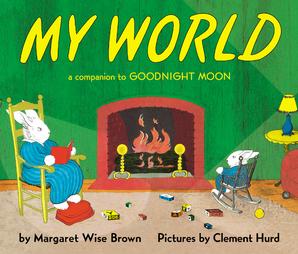Our daughter has fallen in love with Margaret Wise Brown’s two classics Goodnight Moon and The Runaway Bunny. And so, curious about a third foray into this beautiful and poignant world of little bunnies in vast wildernesses and cozy bedrooms, we decided to get My World.
If you haven’t heard of it before, there’s a good reason why. While My World retains some of the magic and mysterious comfort of Brown’s other title, it hasn’t aged nearly as well.
For starters, the book is far more direct in its presentation of culture and society. All of Brown’s books were written in the 1940s, so this shouldn’t surprise us, but page after page of gender stereotypes (momma bunny has to fix breakfast while daddy bunny enjoys his coffee and newspaper) are likely to be off-putting to readers sixty years later. This isn’t a problem with Brown’s other books, preoccupied as they are with primal and timeless concerns like motion and staying, sleep and security. Maybe it would be better to say that My World, concerned as it with with material things, is more shackled to the material things and attitudes that prevailed when the book was written.
Beyond this, the book is actually rather depressing. All of Brown’s books are have overtones of melancholy. You can sense the bunny in Goodnight Moon struggling against sleep and gradually surrendering, and the wistfulness of the mother in The Runaway Bunny who wants to hold and protect her child; this is appropriate for children, and it shows a wonderful respect for the emotional growth of readers… far more so than many contemporary books. But page after page of My World is downright discouraging. “My boy is just a toy bear,” says the bunny after reflecting that he is his parents’ child. “My car won’t go very far,” he says, as he and his father, facing away from each other, bang on their cars. Most children imbue their toys with the power of connection; through these actions and rituals they start to understand the adult world and there is no sense of insufficiency in their play. The bunny in My World, on the other hand, seems utterly convinced of insufficiency. Everything he does is a pale shadow of the real, adult activity going on around him.
Finally, the writing just isn’t that good. There are a few elegiac turns here and there (“The fire burns. The pages turn.” “The moon belongs to the man in the moon.”) but some lines are sloppy and careless, and seem to have been dashed off without much thought: “Daddy’s kitty has gone to the city.” “A low chair. A high chair. But certainly my chair.” (Which chair?) Even the wonderful illustrator Clement Hurd has seemingly missed a page here, since the bunny compares his own pajamas to his father’s, but daddy’s set is nowhere to be seen. This is all the more surprising given the meticulous attention these collaborators have brought to their other work.
There are certainly some interesting things here. The bunny’s comparisons are intriguing, and Brown hasn’t lost her touch at bringing a special power to mundane actions and objects. Much of the writing is beautiful poetry, and My World is probably most engaging in what it illuminates (or shrouds) about its author and her created world. But when the best thing you can say about a childrens book is that it illumates the author, the metaphorical (and, given an impatient listener, perhaps the literal) handwriting is probably on the wall. After Goodnight Moon and The Runaway Bunny, My World is a disappointment.
